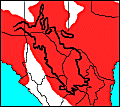


Crotalus atrox. Photographer: Dr. Carl S. Lieb. Baylor Mountains, Culberson Co., TX. UTEP 11479. 11 July 1989.
Total length of adults is 30-84 in. (76-213 cm). Grey, brown, pink, or yellowish above, with light brown to blackish, light edged, diamond-shaped or hexagonal blotches on the back, and fainter smaller blotches on the sides. Most often identified by the evenly spaced black and white rings on the tail, hence its nickname "coon tail."
SE California to Arkansas And East Texas; Arizona, New Mexico, and Oklahoma south to northern Sinaloa and San Luis Potosi. Isolated populations in southern Mexico. Sea level to around 7000 ft. (2130 m).
Crotalus atrox is known to frequent a variety of habitats in arid and semiarid regions including desert, grassland, shrubland, woodland, and pine forest. Within these areas they occur on sandy flats, rocky cliffs, canyons, and rank growth of river bottoms (Stebbins, 1985).
Like most large rattlesnakes, the Western Diamondback feeds mostly on mammals (mice, rats, squirrels, rabbits), but will also consume lizards, birds, and bird eggs.
Live-bearing. Birth usually occurs in late summer or early fall, with litter size averaging 9 to 14, but may have as few as 4 or as many as 23. Newborns are generally 9 to 13.5 in. in length (Tennant, 1985).
Because of its large size, abundance and widespread geographic distribution, this dangerously venomous species causes the greatest number of serious snake bite cases in the U.S. Deaths are rare when proper medical treatment is obtained.
Kinniburgh, R. M. 1972. Distribution of Thermal Responses of the Rattlesnake (Genus Crotalus) in El Paso County, Texas. University of Texas at El Paso.
Klauber, L. M. 1982. Rattlesnakes. University of California Press, Berkeley.
Stebbins, R. C. 1985. A Field Guide to Western Reptiles and Amphibians. Houghton Mifflin Company, Boston.
Tennant, A. 1985. A Field Guide to Texas Snakes. Texas Monthly Press, Hong Kong.
William D. Beltran, July 1997.
Last Update: 11 Jul 2009